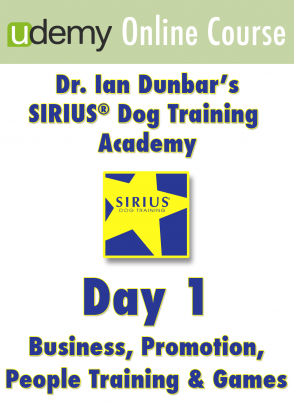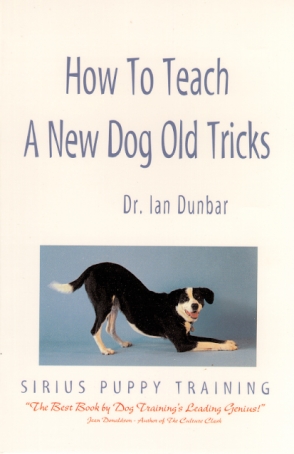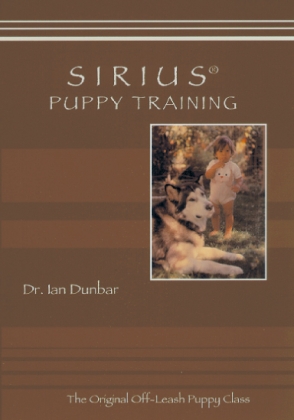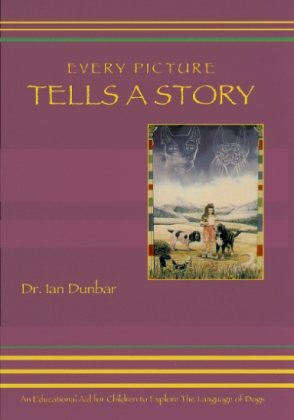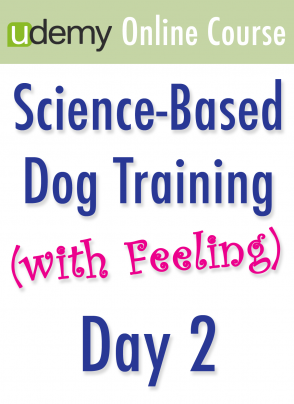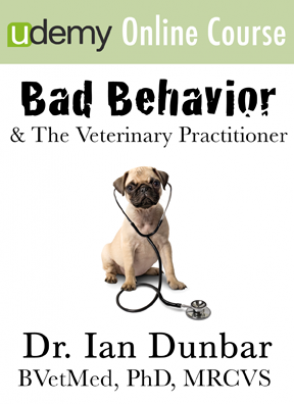Day 1: Business, Promotion, People Training and Games
Bad Puppy Classes?
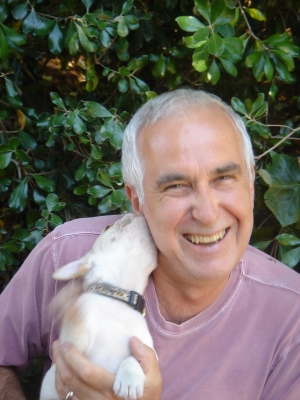
I recently read — How Puppy Class Almost Ruined My Dad’s New Cattle Dog — written by a veterinarian, who blames Puppy Class (and her Dad) for almost ruining her Dad’s puppy, Lucy. I am worried that the sensational and provocative title along with the tabloid style, (replete with “videotaped evidence”, watching “in horror” and the predictable cliff-hanger ending, “To find out what happened, stay tuned for upcoming blogs”), might lead unsuspecting puppy owners to believe that puppy classes are bad news. Consequently, I have decided to reply at length, so that owners realize why they should never let their puppy miss the opportunity of attending classes.
I guess my take on this story is very different. First, I find nothing particularly unusual in terms of Lucy’s behavioral development, all quite normal and expected — calm and compliant as a young puppy until predictable problems began to emerge in later puppyhood. Second, I think that Lucy enrolled in a well-structured puppy class, which she and her owners were obviously enjoying and which was revealing a couple of anticipated, early-adolescent problems that no doubt would have been summarily resolved … had Lucy not been pulled out of class. Third, teaching a two-month old puppy is pretty easy but teaching owners how to maintain the dog’s behavior while she navigates adolescence presents a much more daunting challenge. Welcome to the world of pet dog training!
Obviously, I think that all puppy classes are wonderful. Just being there is beneficial for the pups in terms of socialization, classical conditioning and wealth of experience. However, the effectiveness of instruction varies greatly from trainer to trainer and depends very much on class structure. To maximize benefits, I feel that puppy classes should be taught off-leash for 55 minutes of the hour, (except when teaching leash-walking of course). Teaching puppy classes (compared to adult dog classes) offers the luxury of letting all the puppies off-leash without fear of injury. We should never waste this opportunity — we will never have it again. The younger the puppy, the easier she is to train and modify and mold her behavior and temperament to our liking. Bite inhibition, socialization, temperament “forensics” and temperament training must all be accomplished during puppyhood, whereas basic manners may be taught at any age. However, it’s easier and more fun to train puppies and so, manners are best taught during puppyhood as well.
The two most important goals of puppy class are to enable the puppy 1. To enhance bite inhibition and 2. To socialize with numerous people. Additional goals include, 3. Encouraging puppies to catch up on dog-dog socialization, 4. Diagnosing and immediately resolving incipient and likely problems, 5. Teaching owners how to control and calm off-leash puppies when they are revved-up and especially, 6. That owners and puppies have a great time.
These six vital goals can only be accomplished if puppies are taught off-leash. Puppies can only develop bite inhibition, socialize with people and play with other puppies if they are off-leash. Also, owners cannot learn to control and calm excited pups off-leash, if the puppies are kept on-leash and their behavior is inhibited at all times. Owners live at home with their puppies off-leash and they have come to class to learn how to control them when excited. Thus, in class, numerous, extremely short training interludes need to be integrated into an ongoing, wild and woolly play session, so that “resuming play” may be effectively used a reward for calming and remaining calm. Keeping on-leash puppies calm for extended periods in class masks the real issues: How quickly and effectively can owners calm excited puppies? How quickly can they regain attention and control? Once the owners have mastered prompt and reliable verbal control, and training aids (e.g., food and toy lures and rewards) are no longer necessary for compliance, (which usually takes 1-4 weeks), then they may concentrate on increasing the length of calm, attentive, training time-outs interspersed during playtime.
From the blog, it would appear that Lucy thoroughly enjoyed playing with other dogs and socializing with people and so was well on the road to acquiring reliable bite inhibition and safe jaws. Lucy’s owners also seemed to be having a thoroughly good time in class; “… my parents looked so happy … they were just enjoying their new puppy…” However, she was starting to “blow off her owners” as she began to explore her own doggy interests. Hence the need for “play” and “sniffing” to be the most-used rewards when teaching attention and manners because when she grows up, Lucy won’t live in a protective bubble.
Additionally, off-leash play enables effective behavior and temperament forensics. Off-leash play very rarely creates problems. Play does not make dogs inattentive, fearful, or turn them into bullies, rather off-leash play quickly identifies: 1. Puppies that are already inattentive, fearful, or play too hard and 2. Puppies that are likely to become inattentive, fearful and play too hard as they approach adolescence. Basically, off-leash puppy play enables the instructor (and owners) to view behavior and temperament under a powerful microscope, and, through a crystal ball — to identify incipient problems and to predict future likely problems. For example, most biting dogs may be identified during Week1 play. It is essential to identify incipient or likely problems early on so that owners may be made aware of the problems and immediately embark on their prevention and resolution at a time when prevention and resolution are most effective, i.e., during puppyhood.
I have a lot of respect for Dr. Yin and have enjoyed her writings in the past. However, for her to state that two sessions of puppy class almost ruined her Dad’s 12-week-old puppy is a bit presumptuous, barely supported by the facts and most probably, entirely incorrect. Throughout the blog, Dr Yin repeatedly places as much, if not more, blame on her father’s failure to follow her precise and exceedingly comprehensive, expert instruction as she does on puppy-class damage. Additionally, as a scientist, Dr. Yin must be aware that Correlation does not necessarily equal Causation.
So what else could have transpired here? Do we have a more parsimonious (i.e., more likely) explanation? Well yes, of course we do. The perfect puppy simply grew up. She started to develop predictable and preventable, yet nonetheless essential, adolescent doggy interests (commonly known by some as behavior “problems”). The puppy’s early perfection is no more an advertisement of Dr. Yin’s prowess as a trainer than the developing adolescent’s problems are an indictment of her father’s failure as an owner. Lucy just grew up. And as she grew older, she was much more difficult to train. Dr. Yin had the easy job but her father was faced with an infinitely more difficult task. Of course young puppies are perfect and sit automatically with unwavering attention, the question is: Do they still pay attention and sit reliably after they have collided with adolescence? This is why we have puppy classes — to help owners learn how to deal with these predictable, yet surmountable, “problems”.
Of course puppy Lucy was perfect. She was only eight weeks old AND she was living with a dog expert. That is, until Dr. Yin gave the perfect puppy as a Father’s Day gift to her parents, who presumably are not doggy experts. And then we wonder why the puppy developed “problems”. The puppy-to-adolescent transition happens all too quickly for all breeds but the Australian Cattle Dog is the fastest developing breed on the planet and so, we can expect adolescent problems to start to develop much earlier in puppyhood. Maybe a more suitable parental gift, that is if puppies should ever be gifted at all, would have been a slower-developing and less turbo-charged breed such as a Cavalier King Charles, a Rottie, a Newfie, a Papillon, or an English Bulldog?
I always tell newly qualified veterinarians and dog trainers to never underestimate their own expertise. What may be so easy for you — given your experience and expertise — can be so difficult for others. You must remember that few dog owners are professional dog trainers. Owners are not necessarily irresponsible or incompetent, they simply find dog training difficult.
We have many different cognitive domains and we may be brilliant in some but less than brilliant in others. Entering into an unfamiliar cognitive domain can cause otherwise extremely intelligent people to lose all commonsense, as if their brain fuses. “What little sense I once possessed has gone quite out of my head.” The most common brain-jamming cognitive domains are: technology, (especially, computers and cars), and social situations, (especially, teaching one’s own children, or parents, and training dogs). Much to Kelly and Jamie’s chagrin, my Achilles’ heel is computers. For dog owners, it’s dog training. And for dog trainers, it’s teaching dog training to others. Training dogs and teaching people how to train dogs are two entirely different skills.
Merely telling people what to do is not sufficient, regardless of multi-paged manuals and no matter the number of photographs. I am not being facetious here. I truly appreciate all the effort that Dr. Yin has put into compiling her extremely comprehensive puppy-raising and handling manuals but these are of little use if no one reads them, or if they fail to put the advice to practice. Pet dog training is not about “telling people what to do”, or “doing it for them” and then expecting them to carry on in much more difficult circumstances. Pet dog training is all about motivating dog owners to read instruction manuals, watch instructional videos and try their best to train their dog and then, helping them overcome each and every difficulty along the way. We know this at Dog Star Daily. Providing the information is easy but promoting the site and encouraging prospective and new puppy owners to read the information is an entirely different prospect.
Of course the puppy developed adolescent problems. Wow! So what else is new? Lucy jumps up and likes to play with other dogs. Thank goodness, she’s a normal friendly and socialized puppy with normal puppy interests. Now, all she needs to learn is how to greet people. Yes, we have to re-teach to sit again, because now she is an adolescent and it is a whole new ball game. And yes, we have to re-teach her to pay attention because when she was a puppy, you were her Sun, Moon and Stars, but now she has developed interests of her own — healthy interests, like having fun with other dogs. This is not a capital offence. This is no big deal. All we have to do is integrate training into play so that play becomes the reward for sitting and paying attention. But most important, we have to teach Lucy to enjoy being handled. As a puppy, there was no need to teach her because she simply enjoyed it. But now she is older, she is not enjoying it. And so, we have to teach her to enjoy it.
Raising a puppy, or a child for that matter, is all about preventing predictable problems and identifying incipient problems as early as possible in order to resolve them as soon as possible. It is indeed a rare puppy or child that grows up being perfect. I would be the first to admit that maintaining puppy manners, behavior and temperament through adolescence is far from an easy task but it is possible, IF at least you try.
Ultimately, puppy owners will choose the type of class that they think is best for their puppy. And so, please choose wisely. Your choice will have a long-lasting and indelible effect on your puppy’s manners, behavior and temperament and consequential quality of life as an adult dog. It would seem the choice comes down to an on-leash class with limited play and no off-leash training, or an off-leash class with lots of play and lots of off-leash training. All I can say is, next year, my own puppy school will celebrate the 100,000th puppy in class and there are more than a few puppy owners who are grateful for their adult dog’s bite inhibition, social savvy and reliable off-leash manners.

